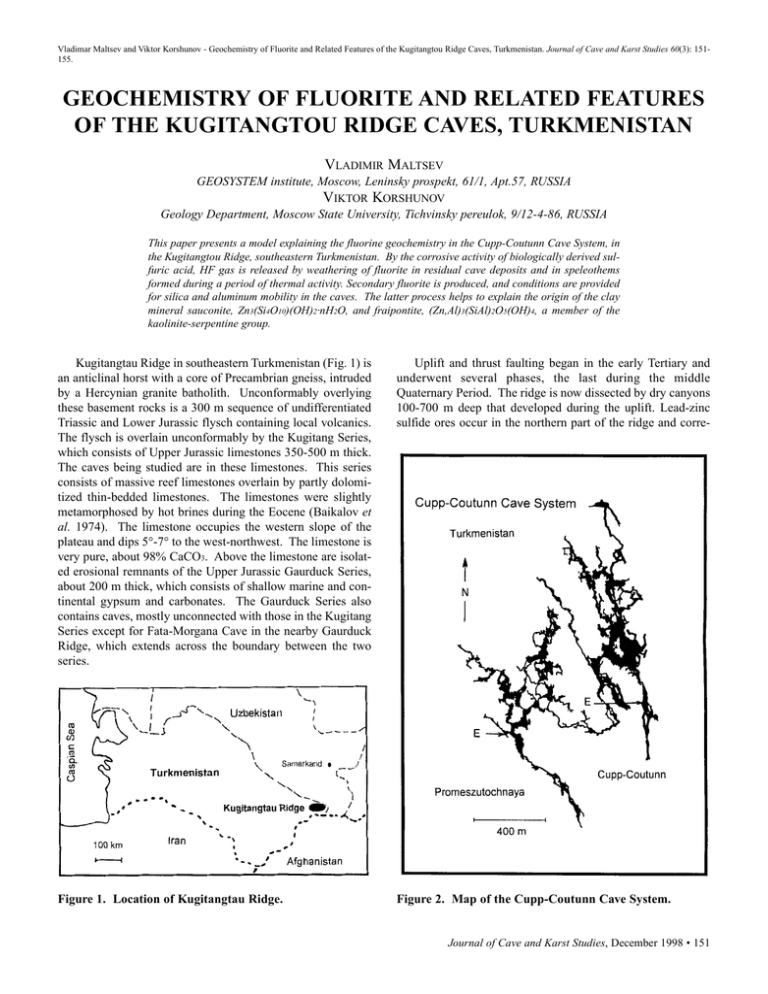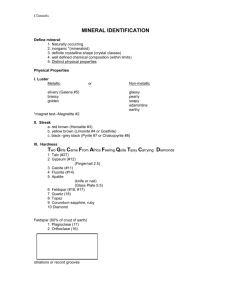Geochemistry of Fluorite and Related Features of the Kugitangtou
advertisement

Vladimar Maltsev and Viktor Korshunov - Geochemistry of Fluorite and Related Features of the Kugitangtou Ridge Caves, Turkmenistan. Journal of Cave and Karst Studies 60(3): 151155. GEOCHEMISTRY OF FLUORITE AND RELATED FEATURES OF THE KUGITANGTOU RIDGE CAVES, TURKMENISTAN VLADIMIR MALTSEV GEOSYSTEM institute, Moscow, Leninsky prospekt, 61/1, Apt.57, RUSSIA VIKTOR KORSHUNOV Geology Department, Moscow State University, Tichvinsky pereulok, 9/12-4-86, RUSSIA This paper presents a model explaining the fluorine geochemistry in the Cupp-Coutunn Cave System, in the Kugitangtou Ridge, southeastern Turkmenistan. By the corrosive activity of biologically derived sulfuric acid, HF gas is released by weathering of fluorite in residual cave deposits and in speleothems formed during a period of thermal activity. Secondary fluorite is produced, and conditions are provided for silica and aluminum mobility in the caves. The latter process helps to explain the origin of the clay mineral sauconite, Zn3(Si4O10)(OH)2·nH2O, and fraipontite, (Zn,Al)3(SiAl)2O5(OH)4, a member of the kaolinite-serpentine group. Kugitangtau Ridge in southeastern Turkmenistan (Fig. 1) is an anticlinal horst with a core of Precambrian gneiss, intruded by a Hercynian granite batholith. Unconformably overlying these basement rocks is a 300 m sequence of undifferentiated Triassic and Lower Jurassic flysch containing local volcanics. The flysch is overlain unconformably by the Kugitang Series, which consists of Upper Jurassic limestones 350-500 m thick. The caves being studied are in these limestones. This series consists of massive reef limestones overlain by partly dolomitized thin-bedded limestones. The limestones were slightly metamorphosed by hot brines during the Eocene (Baikalov et al. 1974). The limestone occupies the western slope of the plateau and dips 5°-7° to the west-northwest. The limestone is very pure, about 98% CaCO3. Above the limestone are isolated erosional remnants of the Upper Jurassic Gaurduck Series, about 200 m thick, which consists of shallow marine and continental gypsum and carbonates. The Gaurduck Series also contains caves, mostly unconnected with those in the Kugitang Series except for Fata-Morgana Cave in the nearby Gaurduck Ridge, which extends across the boundary between the two series. Uplift and thrust faulting began in the early Tertiary and underwent several phases, the last during the middle Quaternary Period. The ridge is now dissected by dry canyons 100-700 m deep that developed during the uplift. Lead-zinc sulfide ores occur in the northern part of the ridge and corre- Figure 1. Location of Kugitangtau Ridge. Figure 2. Map of the Cupp-Coutunn Cave System. Journal of Cave and Karst Studies, December 1998 • 151 GEOCHEMISTRY OF FLUORITE AND RELATED FEATURES OF THE KUGITANGTOU RIDGE CAVES, TURKMENISTAN Figure 3. A remnant of thermal fluorite with visible traces of corrosion. spond to sulfide veins in the caves. Their age relationship to the caves is disputed (see later discussion). There are also sulfur deposits from biologically mediated reduction of the Gaurduck gypsum beds and of the caprock over several salt domes. The Cupp-Coutunn Cave is in the southern part of the plateau and is the largest limestone cave of the former USSR, at 53 km long and 310 m deep (Fig. 2). It represents only a small percentage of an extensive karst system containing many caves. The evolution of caves in the ridge is interpreted as follows: (1) During the Late Cretaceous, phreatic development of solution mazes took place below the contemporary erosional surface, which were later filled with clays. (2) These relict caves were rejuvenated by middle Quaternary tectonic uplift. Quaternary drainage through the caves was fed by phreatic water along faults. Therefore, surface canyons of the same age (in places only a few meters above the caves) have almost no connection with the underlying caves, except where there has been local collapse. (3) A thermal phase followed soon afterward, although the source of the thermal water is uncertain. Calcite, fluorite, and sulfide minerals were deposited at that time (Fig. 3). Oxygen isotope ratios in the thermal calcite suggest that the water was derived from the deep basement. (4) A dry phase followed soon after the thermal invasion and continues today. There is now no known active water flow in the cave, and only a few small lakes are present. FLUORITE PRECIPITATION AND DISSOLUTION IN THE CAVE ENVIRONMENT Fluorite deposits have been known in the caves of the Kugitangtou Mountains since 1985, particularly in the CuppCoutunn Cave System (Maltsev & Bartenev 1989), but many related features have remained unexplained until recently. Three types of fluorite occur in the caves: hydrothermal veins 152 • Journal of Cave and Karst Studies, December 1998 and deposits, residual weathering fragments derived from the veins, and modern secondary fluorite that is still being deposited in the caves. Thin, light-purple fluorite veins of Upper Jurassic age are indigenous to the limestones of the Kugitangtou Series. The fluorite was precipitated at 150°-200°C, as shown by temperatures of homogenization (see also Berkeliev 1995). The number and density of fluorite veins in the cave are more than ten times greater than at the surface, suggesting that the fluorite may have formed during a hydrothermal phase of cave formation. This fluorite also shares the characteristics of hydrothermal fluorite known to have formed in other caves (from personal observation, corroborated by Berkeliev 1995). For example, it completely lacks rare-earth elements, so there is no phosphorescence or fluorescence. Weathering of the veins during and after cave development has produced abundant detrital fragments of fluorite, which in places form a granular debris on the cave floors. This concentration of detrital fluorite is fostered by the lack of high-velocity groundwater to remove the material. An unresolved question is the reason why the fluorite has undergone such intense chemical weathering. Although the crystals are transparent, euhedral, and unfractured, in some areas they shatter into small fragments when touched, while elsewhere they remain uncorroded. Physical weathering is impossible in the static cave climate, and the well-preserved euhedral faces of the crystals suggest that the weathering is not biological. The disintegration appears to be a cave-related process, because the interiors of the veins are less intensely weathered than the outsides. Cave-related hydrothermal fluorite was also deposited at low temperatures of about 80°-170° C during the Quaternary hydrothermal phase of cave development (Maltsev & Malishevsky 1991). This fluorite has the same unusual properties as the vein fluorite described above but is not as strongly weathered, even though it has experienced lengthy exposure to the cave atmosphere. The relationship between these two processes is still unresolved. Both of these non-recent types of fluorite show evidence of dissolution that penetrates as much as 4 cm along fractures in the crystals. Previously (Maltsev & Malishevsky 1991) this dissolution was thought to have occurred during the final phase of hydrothermal invasion of the caves, but it is now interpreted as corrosion by modern sulfuric acid produced by microbial activity, which is described later. Recent studies show that this simple division of fluorite into residual and cave-related hydrothermal is in some doubt. In the Skazka-Dalnaya area of the Cupp-Coutunn Cave is a third type of “old” fluorite, which, although possibly deposited in a separate event, may instead be a combination of the two types described above. The cave history includes a long period when the cave was at least partly filled with clays (Maltsev & Self 1992), although age estimates of troglobitic fauna by S. Smirnov (personal communication) indicate that the cave was partly open since the early Tertiary. In the Skazka-Dalnaya area of the cave this MALTSEV AND KORSHUNOV Figure 4. Two views of young secondary fluorite growing upon calcite helictites and gypsum crystals. ancient clay has been completely altered by thermal waters, with fluoritization as the main alteration feature. The fluorite in this sediment has at least 5 generations, ranging from white to dark purple, in crystals up to 15 cm long. Some are faceted, but others with many clay inclusions are not. Druses of euhedral fluorite crystals have formed at the contact between the clay and the limestone bedrock, penetrating the limestone as much as 1-2 m along fractures, forming micro-veins and replacing the calcite in fossil bryozoa. Fluorite is accompanied by quartz, galena, several iron minerals, and dolomite, all of which are very finely crystalline. It is possible that some of the veins and druses in which the sediment has been removed were mistakenly considered “vein fluorite” or “cave-related thermal fluorite.” Further study is needed to clarify these relationships. Berkeliev (1995), who also studied this location, concluded that the fluoritization was of Eocene age. This does not contradict our general model of cave evolution, which envisions the cave being filled with clay throughout the Eocene. However, we cannot agree with Berkeliev’s conclusion that this fluorite was a pre-karst vein, for the following reasons: (1) The location studied is a dense maze 200 m long and 60 m wide, in which the fluorite deposits are contiguous. Such a gross widening of a “vein” is improbable, and its discordance to the bedding and to tectonic structures disproves the pre-karst hypothesis. (2) The morphology of the fluorite deposits does not differ from those of other ancient cave fills, and contacts with the limestone are of exactly the same nature. The geometry of the fluorite zone is exactly the same as that of the filled cave. (3) The micro-veins and replaced fossils are localized within 1-2 m of the cave walls (now exposed by later karst processes). They are not related to tectonic structures. (4) The clay inclusions in unfaceted fluorite crystals show that the cave clays pre-dated the fluorite. This phenomenon is absent outside the caves. Of greatest interest are abundant deposits of modern fluorite, which were first discovered in 1989 . The modern fluorite consists of small (up to 0.3 mm) dark purple crystals growing on the surfaces of calcite and gypsum speleothems (Maltsev & Belyakovsky 1992; see Fig. 4). Evidently the only way this fluorite could precipitate was by the reaction of airborne HF with calcium in or beneath thin films of water, where the calcium source is either calcite or gypsum in the substrate. The earliest suggestion for the presence of HF was in a hypothetical model proposed by Berkeliev et al. (1992), but they proposed that the HF was in aqueous solution. To the contrary, the only feasible method of transport of fluorine is as HF gas. Aqueous fluoride requires a very low pH, which would dissolve the calcite beneath the thin water films and cause immediate precipitation of fluorite on nearby calcite or gypsum surfaces. It is interesting to note that the modern fluorite is actively precipitating in a non-hydrothermal environment. In one place it covers euhedral gypsum crystals that are 3-5 cm long, penetrating the gypsum no more than 0.05 mm. Gypsum speleothems in the Cupp-Coutunn Cave grow only during the wet season by recrystallization of older gypsum deposits. Euhedral gypsum faces are present only where crystal growth has been fast enough to offset periodic episodes of dissolution. The surficial fluorite is estimated to be 30-100 years old. The measured rate of gypsum growth on calcite helictites in the Cupp-Coutunn Cave is 0.01-1.5 mm/yr, and some fluorite crystals extend 0.1 mm beneath the euhedral crystal faces of gypsum and project outward as much as 0.3 mm beyond them. This represents a 4:1 ratio of growth rate for the fluorite vs. gypsum. This relative rate is impossible in cold water that does not contain strong acids, but the pH of water films on the crystals is rather high (6.5-7.0). Any acid in capillary water seeping through the carbonate bedrock or speleothems would be almost immediately neutralized. The fluorite crystals are uniformly distributed along the helictites, and if the fluorite had been carried by the original speleothem-forming solution, its distribution would vary with evaporation rate. The origin of the fluorite must therefore be HF in the cave air. Journal of Cave and Karst Studies, December 1998 • 153 GEOCHEMISTRY OF FLUORITE AND RELATED FEATURES OF THE KUGITANGTOU RIDGE CAVES, TURKMENISTAN Figure 5. Okher coating on the cave wall, showing visible transformation of small calcite veins into gypsum boxwork. PROPOSED MODEL FOR FLUORITE PRECIPITATION So far the source of the HF gas has been explained only theoretically, because there are no reliable, direct methods for detecting it in the underground environment. The only substances in the cave containing fluorine are the two older fluorite deposits. Corrosion of these deposits to produce HF is feasible at the present cave temperatures only by sulfuric acid (Maltsev 1993). The source of the sulfuric acid could not be from oxidation of sulfide minerals, since sulfide-rich veins are very sparse in the cave, and even where they are most abundant they represent only 0.5-1.5 kg of sulfides per meter of passage length. In contrast, these passages contain 70-100 kg of fluorite per meter of passage length, and the fluorite has been about 10% corroded. Therefore an additional source of sulfuric acid is needed. There is also no available mechanism for the transport of sulfuric acid, as it is not volatile, and if it moves as a thin film over carbonate surfaces it becomes neutralized almost immediately. Thus the sulfuric acid must be generated in the immediate vicinity of the fluorite and is apparently a byproduct of microbial activity in the weathered zone (Korshunov et al. in prep.). Corrosion of the fluorite is limited to areas in the immediate vicinity of highly weathered surfaces, whereas elsewhere it remains uncorroded. Both bacterial sulfate reduction and sulfide oxidation are active in a red, clay-like coating, referred to here as “okher,” on the walls and ceilings in the Kugitangtou Ridge Caves (Fig. 5). The term okher is not equivalent to the English word ocher, which is an earthy form of iron oxide. Okher consists of weathered bedrock in a reducing environment that grades into a residual clay-rich zone where oxidation of sulfides turns the surface into a red, iron-oxide rich powder. The sulfur cycle within the okher progresses from gypsum in infiltrating groundwater to H2S to H2SO4, and this appears also to be the main cave-enlarging process still active in the Cupp-Coutunn Cave. H2SO4 is able to dissolve fluorite, liberating HF gas, and 154 • Journal of Cave and Karst Studies, December 1998 Figure 6. Sauconite spherulites up to 1 cm in diameter. the modern fluorite precipitates in the vicinity of the okher. In support of this idea, deposits of fluorite that have broken off from the active okher sites are significantly less dissolved than the hydrothermal fluorite crystals and fluorite veins still in contact with the okher. Moreover, fluorite is absent in those areas where the okher is most extensive, probably having been completely removed by dissolution. RELATED PROCESSES HF gas in the cave air is further substantiated by the presence of secondary aluminosilicate minerals in the cave. The most obvious source of the aluminosilicates is residual material from the limestone in the okher crust. Aluminosilicates are highly prone to dissolution by hydrofluoric acid, and therefore SiF4 gas, soluble hexafluoric siliceous acid (SiF6), and similar aluminum compounds must form in the cave. SiF6 and AlF6 are relatively stable and their salts are very soluble. For example, CaSiF6 is more than ten times more soluble than gypsum. The cave-related zinc silicates sauconite (Maltsev & Belyakovsky 1992), fraipontite (Berkeliev et al. 1992), and several unidentified minerals whose origin is still unclear, probably represent the secondary precipitation of the dissolved aluminosilicates. These minerals usually form spherules up to 1 cm in diameter located within 10 cm of sulfide veins in the limestone (Fig. 6). They occur beneath calcite flowstone and along fractures on the surface of the flowstone, which indicates that they originated in the cold water environment of the caves. The surrounding calcite is not especially altered, so the zinc silicates must have been deposited by local processes that rapidly lose their effect away from the veins. Sulfide veins cannot have been a source of silica and aluminum, as they contain few of these ions. The gases described above seem a likely source of ions for the observed mineral deposits, as they contain both silica and aluminum and are aggressive toward sphalerite. Other silicates found in the northern part of the cave may have an origin similar to that of the secondary alu- MALTSEV AND KORSHUNOV ACKNOWLEDGMENTS Nina Skorobogatova, Mikhail Korotaev for their help with the measurements of luminescence and paleotemperature. Arthur N. Palmer (State University of New York) edited this paper and revised the English. Carol A. Hill (Albuquerque, NM) and Margaret V. Palmer (Oneonta, NY) reviewed the manuscript and suggested several revisions. REFERENCES Figure 7. An as-yet unidentified silicate replacing the interiors of gypsum “clouds.” minosilicates, but their amorphous structure and occurrence as mixtures of several different minerals makes them difficult to identify (Fig. 7). The strongest evidence for the HF gas in the cave air is the alteration of metal objects left in the cave (Maltsev & Self 1992) . Where microbial processes are active, aluminum survey markers, installed in 1985, disintegrated entirely by 1989, leaving viscous to glassy spherules. Some of the spherules consist of allophane, while others have not yet been identified but appear to be aluminosilicates. The aluminum has apparently been attacked by a strong acid. In the case of the survey markers, sulfuric acid from the okher may have been responsible, but in other cases this is impossible. A five-meter-long ladder, consisting of steel wires with aluminum rungs, and hanging away from the walls and the okher, was also destroyed within three years. Sulfuric acid is not volatile, and the slow movement of water films would leave a trail of decreasing corrosion on the ladder, which was absent. This leads us to assume that the acid was airborne, and the local geochemistry suggests that it could only be hydrofluoric acid. Baikov, A.A., Berkeliev K.P. & Zhdanov B.P. (1974). Geology and mineral resources of the Gaurduck-Kugitang district of the Turkmenskaya SSR. Rostov-Na-Donu, Izdatelstvo RGU: 261 p. Berkeliev, T.K. (1995). Fluorite genesis in the Kugitangtau caves. Izvestiya Akademii Nauk Turkmenistana 2: 140-143. Berkeliev, T.K., Pautov, L.A. & Ignatenko, K.I. (1992). Fraipontite—a find in Turkmenistan. Mineral Journal 12: 84-87. (in Russian, English abstract). Korshunov, V.V., Semikolennykh, A.A. & Maltsev, V.A. (in preparation). A model of speleogenetic processes, connected with bacterial redox and sulfuric cycles in the caves of Kugitangtou ridge (Turkmenistan). Maltsev, V.A. (1993). Minerals of Cupp-Coutunn karst cave system. World of stones: Moscow: 15-30. Maltsev, V.A., & Bartenev, O.S. (1989). Results of mineralogical studies in the Cupp-Coutunn cave system in Turkmenia. Problem of Complex Karst Study of Mountainous Countries, Tbilisi, Metsniereba: 209-211. (in Russian, with English abstract). Maltsev, V.A. & Belyakovsky, D. (1992). The Kap-Kutan cave system in the Kugitang mountains in East-Turkmenia. Lapis Mineralien Magazin 17: 13-18 (in German). Maltsev, V.A. & Malishevsky, D.I. (1991). On hydrothermal phases during later stages of the evolution of Cupp Coutunn cave system, Turkmenia, U.S.S.R. National Speleological Society Bulletin 52: 95-98. Maltsev, V.A. & Self, C.A. (1992). Cupp-Coutunn cave system, Turkmenia, Central Asia. Proceedings of the University of Bristol Speleological Society 19: 117-149. CONCLUSIONS Fluorine plays a significant role in the geochemistry of the Cupp-Coutunn Cave System, both in depositing fluorine-bearing minerals, and in transporting silica. The latter may help to explain the origin of various silicates in the cave whose origin has previously been uncertain. Most of the fluorine-related processes appear to be activated by airborne HF, although the evidence is indirect, since it has not yet been measured. Measurement of HF and SiF6 gas in the cave air is an important goal, as their concentrations in some places in the cave may approach toxic levels. Journal of Cave and Karst Studies, December 1998 • 155




